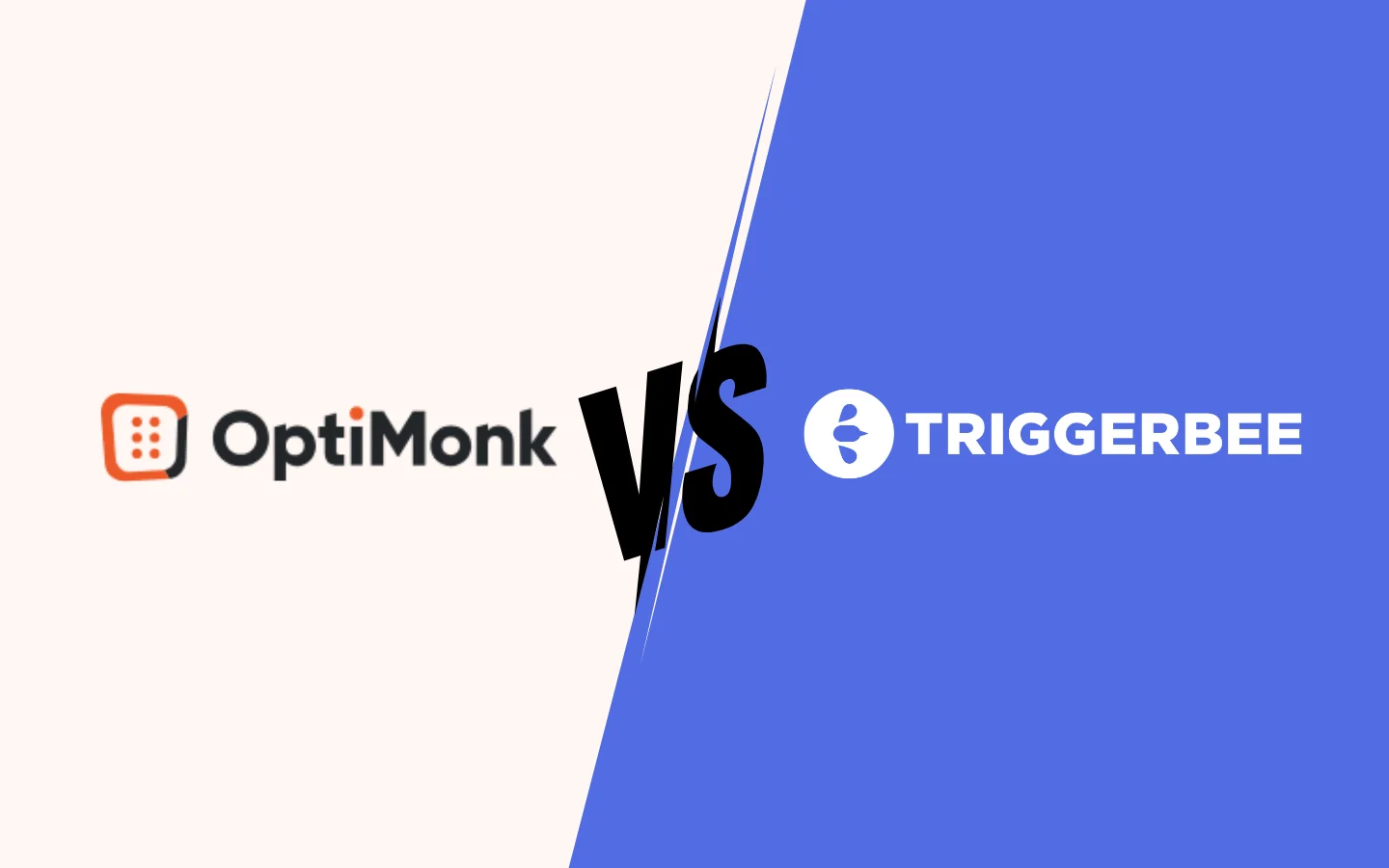In this comparison, we’ll look at OptiMonk vs Triggerbee. Two powerful platforms for onsite marketing, lead capture, and customer engagement. Both tools offer popups, A/B testing, targeting rules, and a wide range of integrations – but the way they approach personalization, design control, and data syncing is different. If you’re looking for an Optimonk alternative, Triggerbee is a great choice.
Triggerbee: Built for teams who want full personalization and deep CRM targeting
Triggerbee isn’t just a popup tool. It’s a personalization engine. You can create fully branded campaigns, target visitors with CRM-based logic, and personalize content sitewide – from popups to embedded banners. It’s ideal for ecommerce, B2B, and subscription brands that want their website to reflect their customer data in real time.
Triggerbee is best for teams that care about advanced targeting, syncing with their marketing stack, and turning visitor behavior into personalized experiences that convert.
Optimonk: Easy to start, quick to scale
OptiMonk is built for teams that want fast results with minimal setup. You get a generous free plan, polished templates, and user-friendly targeting tools. It’s especially helpful for Shopify-based businesses thanks to its native integration and onboarding flows.
If your focus is launching campaigns quickly and testing ideas, Optimonk is a solid choice – especially if you run or work at a small to mid-sized ecommerce store.
Let’s dive in!
Optimonk vs Triggerbee Comparison
| Feature | Triggerbee | OptiMonk |
|---|---|---|
| Campaign Types (popups, embeds) | ✅ Popups, Embeds, Callouts, Full screen, Banners | ✅ Popups, Embeds, Full screen, Bars |
| Forms | ✅ Yes | ✅ Yes |
| Promotions | ✅ Yes | ✅ Yes |
| Gamification | ✅ Spin to win, Memory, Product quizzes, Calendars, Daily offers | ✅ Spin to win |
| Surveys | ✅ CSAT & NPS with analytics, Ratings, Smileys, Thumbs, Stars + feedback field | ✅ Simple surveys with feedback fields |
| Referral marketing | ✅ Yes | ❌ No |
| Targeting | ✅ Session behavior, profile properties and events | ✅ Behavioral triggers, page-level, time-on-site, scroll |
| Advanced Onsite Targeting | ✅ Weather targeting, Geolocation, CRM data | ❌ No weather targeting or geolocation |
| Smart Embeds | ✅ Yes, audience-targeted content injected via CSS class | ❌ No Smart Embeds |
| Personalization Features | ✅ CRM-targeting, Customer Profile Targeting | ✅ Text-based personalization only |
| A/B Testing | ✅ A + B | ✅ A/B testing |
| Analytics & Reporting | ✅ Revenue attribution, funnel analysis | ✅ Basic campaign metrics, conversions, impressions |
| Product recommendations | ✅ With integrations | ✅ For Shopify only |
| Brand Default Styles | ✅ Yes | ❌ No |
| Integrations | ✅ Multiple native + Zapier | ✅ Broad range, mostly lead sync |
| Freemium | ❌ No | ✅ Free up to 10,000 views |
| Free Trial | ✅ 14 days and 250k page views | ✅ 14 days |
| Pricing | Starts at €39 | Starts at $44 |
| Best For | Brands that want more personalization, customization and CRM-based targeting | Ecommerce brands who want fast results and easy campaign setup |
1. Who Each Tool Is Best For
Choosing between Optimonk and Triggerbee depends on your goals, team size, and how far you want to go with personalization. Both tools cover the essentials of popup creation and lead capture, but they’re built with different users in mind. Optimonk is ideal for marketers who want to move fast with polished templates and simple campaigns. Triggerbee is better suited for brands ready to use behavioral data and CRM insights to deliver personalized, high-converting experiences across their site.
Triggerbee: Built for brands that want full control and deeper targeting
Triggerbee is designed for marketing teams who don’t just want to launch popups-but want to personalize the entire experience. It’s a great fit for ecommerce, B2B, and membership-based businesses that already use CRM data and want to connect it directly to onsite campaigns.
Triggerbee lets you decide exactly who sees what, and when. That includes showing unique offers to logged-in users, subscribers with certain tags, or high-value shoppers. If you’re using tools like Rule, Klaviyo, or Mailchimp, you’ll be able to sync segments and trigger campaigns with zero guesswork.
It’s slightly more expensive at lower traffic volumes-but you get full personalization, targeting, and analytics from day one.
Optimonk: Great for quick wins and AI-powered optimization
OptiMonk is ideal if you want to set up high-converting popups fast. It gives you prebuilt templates, a friendly drag-and-drop builder, and built-in AI features to help improve performance over time.
The platform focuses more on ease of use than manual control. You won’t get deep CRM integrations or custom logic at the same level as Triggerbee-but for many small to mid-sized ecommerce stores, that’s not a dealbreaker.
You can start for free, and pricing stays competitive up until around 250,000 monthly views. After that, Triggerbee offers more flexibility without steep jumps in cost.
2. Campaign Creation & Templates
Creating effective campaigns should be fast, flexible, and intuitive. Whether you’re building a simple popup or a multi-step flow with personalized offers, the right editor makes all the difference.
Look for tools that offer both ready-made templates and the flexibility to build from scratch, with elements like countdown timers, gamification, product blocks, and mobile-first layouts.
The more control you have in the builder, the easier it is to match your brand and launch higher-converting ideas, faster.
Triggerbee: Visual builder with full control
Triggerbee gives you a drag-and-drop editor built for precision. You can create multistep campaigns, quizzes, surveys, or embedded banners and control exactly how they appear. Want to match your brand guidelines? Just set your fonts, colors, and spacing once – every campaign will follow them by default.
You also get access to advanced logic and design blocks like deadline counters, product cards, coupon codes, and conditional steps. If needed, you can go even further with custom code, HTML, or inline styles. It’s everything a design-conscious team needs to build campaigns that convert and still feel native to the site.
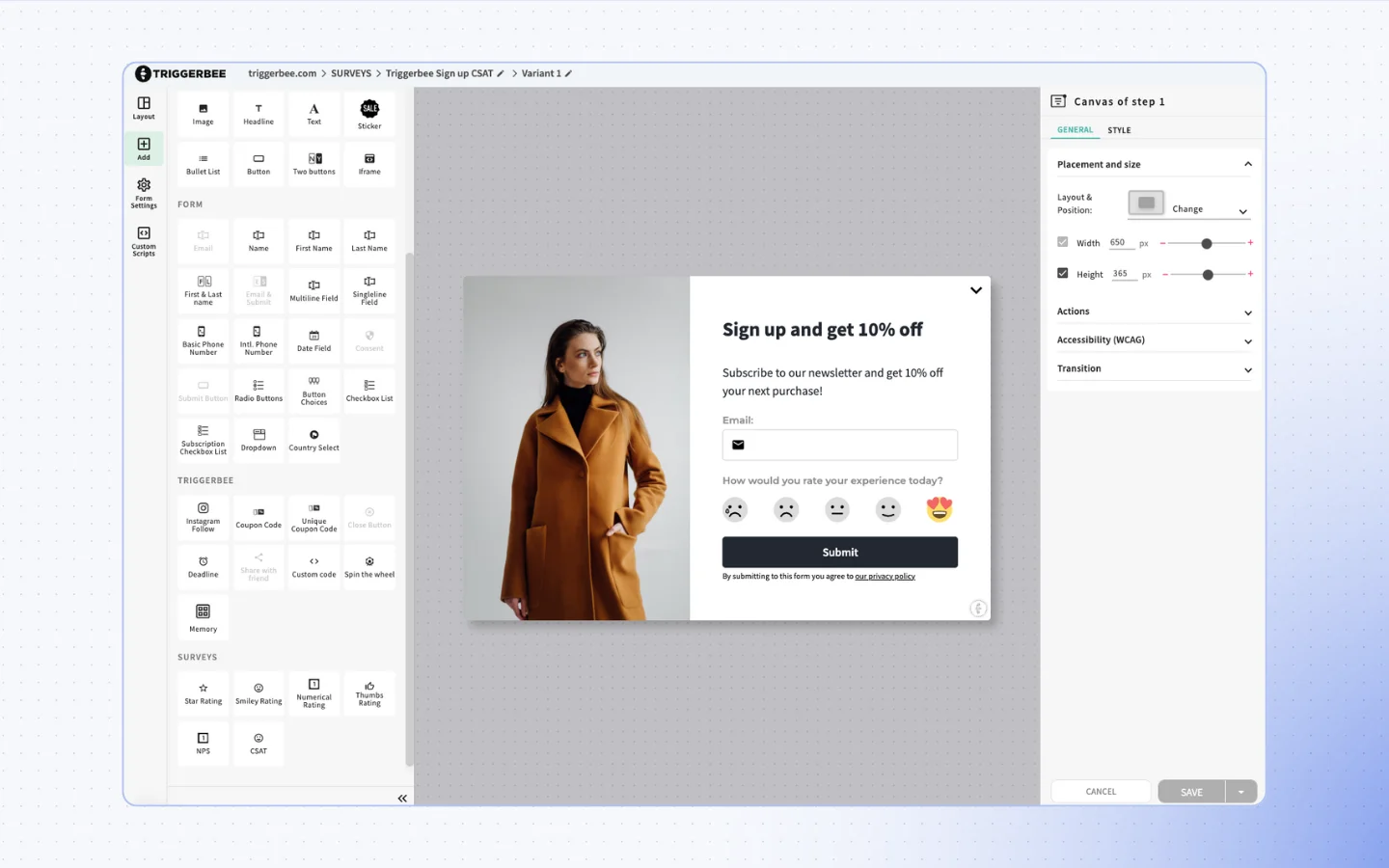
Why it matters: No design bottlenecks, no extra styling work, and no off-brand overlays.
Optimonk: Template-first builder that’s easy to use
Optimonk makes it easy to launch a popup fast. You start with a clean template and a block-based builder that covers basic inputs, product showcases, and timers. You can build a thank-you step or teaser step using the built-in page flow, and tweak fonts and spacing to fit your brand – but with some limits.
The UI is polished and beginner-friendly, and the overall system is great for teams who want to move quickly. Just note that advanced layout logic and content personalization are more limited unless you rely on external data.

What to keep in mind: Fast and accessible, but not ideal for complex or fully branded campaign layouts. The UI is polished and beginner-friendly, but some styling and logic options are more rigid.
Quick verdict
Choose Triggerbee if you care about layout control, brand styling, and advanced flows. Choose Optimonk if you want a fast setup, great templates, and built-in AI for optimization.
3. Targeting & Triggers
The real power of targeting comes from combining context and intent. It’s not just about when a campaign appears, but why it appears, and who it’s shown to.
Good tools let you trigger campaigns based on behavior (like scroll depth or exit intent), session data (like time on site or device), or traffic source (like UTM tags). But GREAT tools go further by layering in CRM data, purchase history, and audience segments so your targeting reflects both real-time behavior and long-term customer context. This is where the biggest performance lift often happens.
Triggerbee: Deep segmentation with CRM, session, and context rules
Triggerbee gives you full control over who sees your campaigns. You can trigger messages based on session behavior, cart value, CRM data, or audience tags synced from tools like Klaviyo or Rule. It even supports weather-based targeting and geolocation if you want to adapt messaging to real-world conditions.
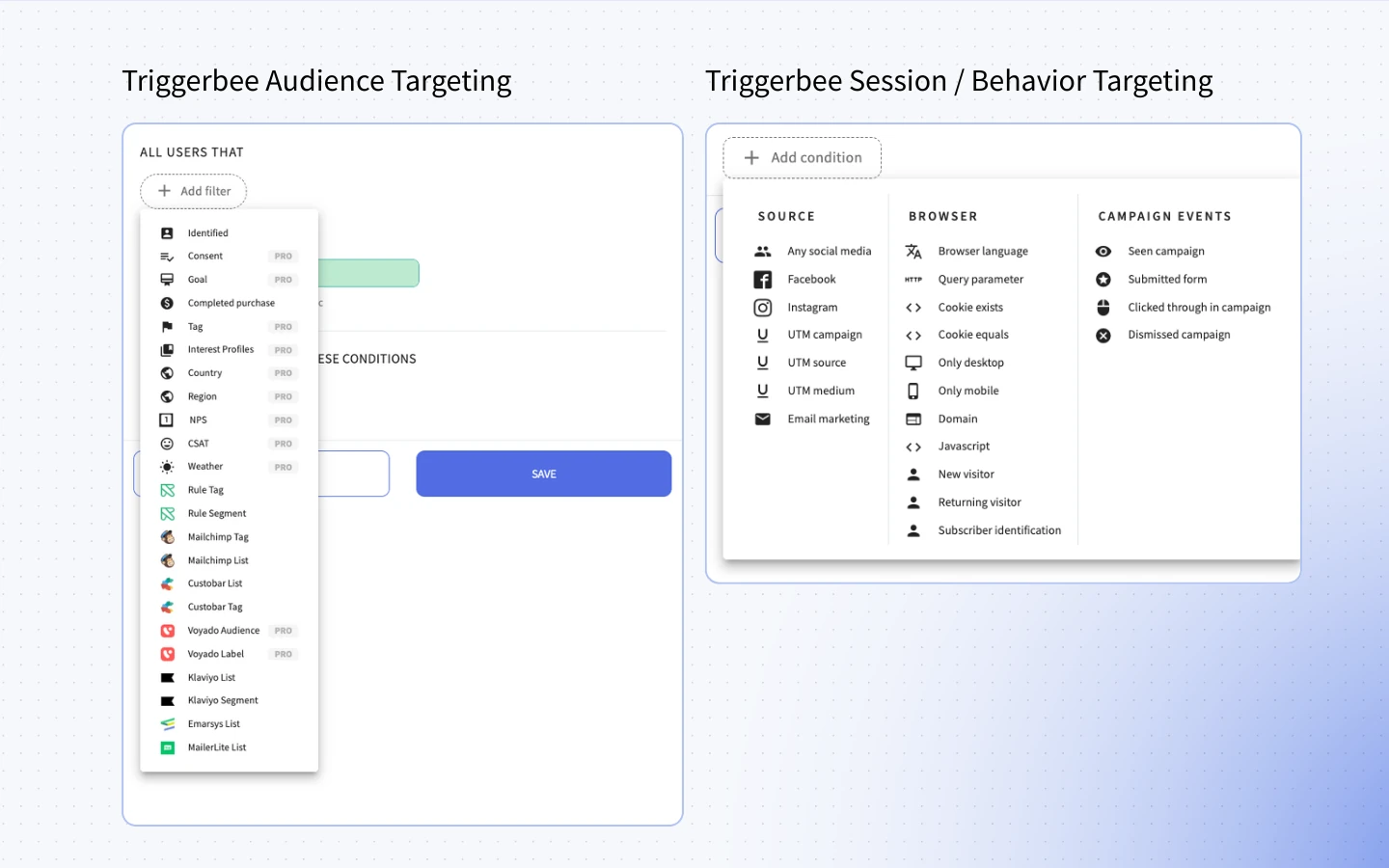
You also get full visibility into each targeting condition, and it’s easy to layer them using AND/OR logic. Want to show a campaign to subscribers in Sweden who visited a specific product twice? You can.
Why it matters: The more specific your targeting, the less you interrupt and the more you convert.
Optimonk: Smart rules for everyday use cases
Optimonk comes with a strong library of behavioral targeting conditions: time on page, number of visits, referral source, device, and more. You can trigger campaigns based on exit intent, scroll depth, clicks, or inactivity, and use cart rules or UTM parameters to refine when popups appear.
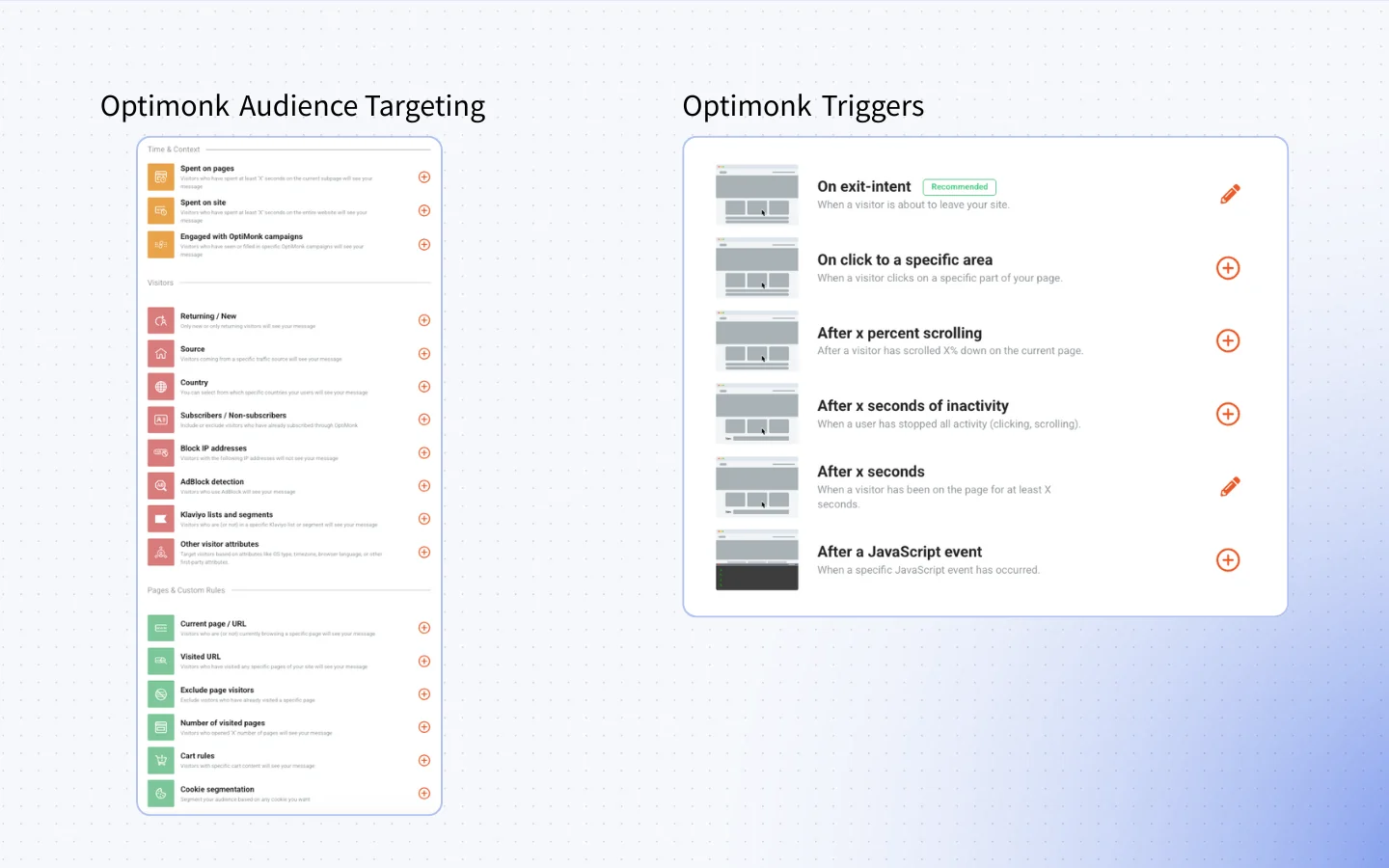
While it supports external data like Klaviyo segments or IP blocking, it doesn’t connect as deeply into CRM fields or visitor property logic as Triggerbee. That said, it’s still a strong setup for teams who want to use standard targeting strategies without overcomplicating their workflow.
What to keep in mind: Easy to set up and flexible enough for most ecommerce use cases – just not quite as customizable at the data level.
Quick verdict
Choose Triggerbee if you want the most advanced targeting and CRM-driven rules available. Choose OptiMonk if your use cases are more common (cart abandoners, exit intent, mobile triggers) and you want speed without setup complexity.
4. Personalization Options
Personalization is about delivering the right message, offer, or experience to each visitor based on who they are, what they’ve done, and what they’re likely to do next.
Strong personalization tools connect to your CRM or customer database, let you insert dynamic content into campaigns, and give you control over which segments see what. Whether it’s showing different promotions to new vs. returning users or displaying loyalty points for logged-in members, your personalization engine should adapt to real people in real time.
Triggerbee: Personalized content that runs on CRM data and rules
Triggerbee lets you go beyond “Hi {{first name}}.” You can personalize the full content of a popup, banner, or embedded section based on a visitor’s location, session behavior, purchase history, or CRM segment. Campaigns can be shown or hidden based on dozens of data points, and you can preview every variation before going live.
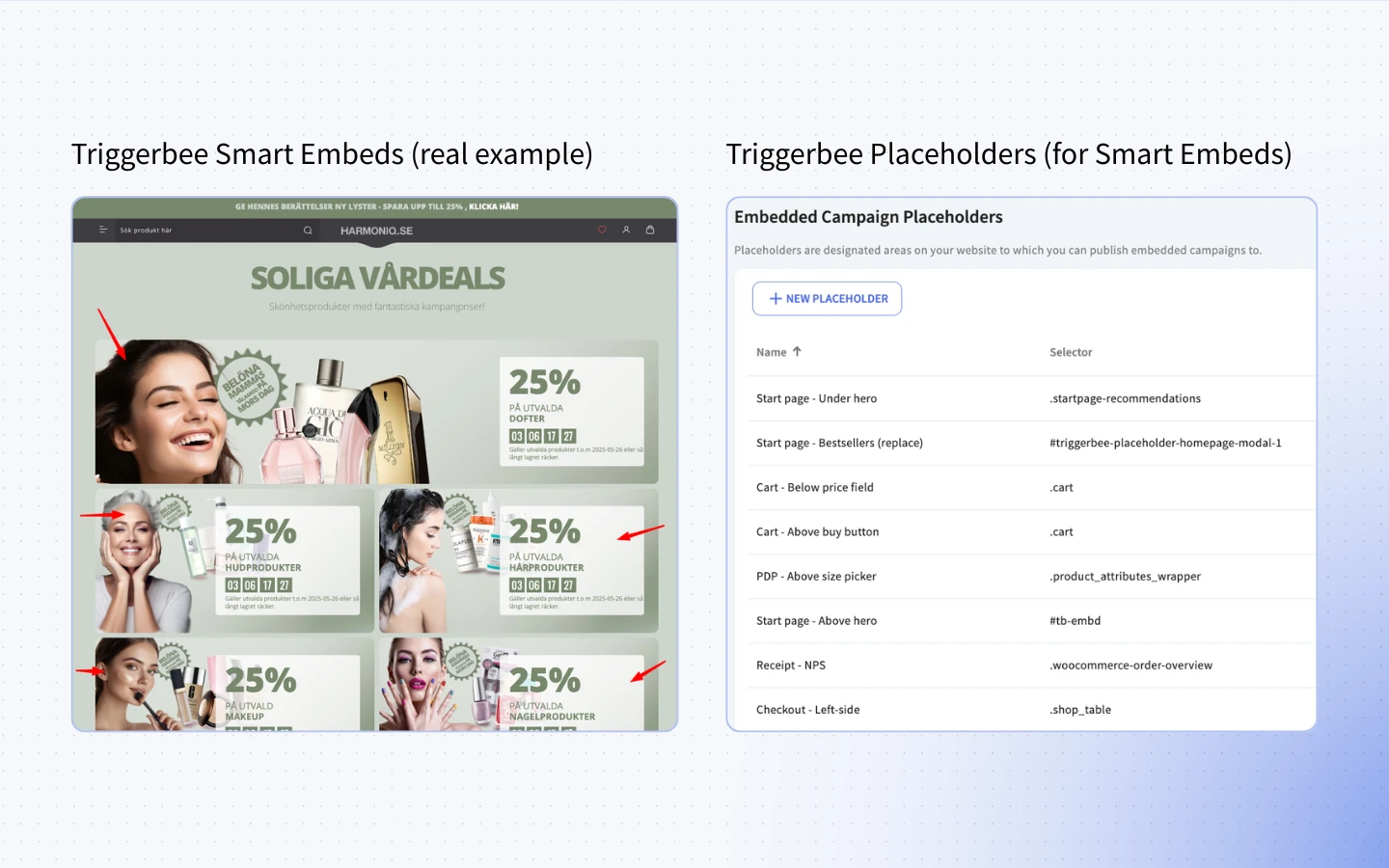
You also get Smart Embeds – personalized campaigns placed directly inside your website’s layout using CSS selectors. This lets you personalize static content areas like product pages or checkout zones.
Why it matters: You don’t just change names. You change what people see – based on who they are.
Optimonk: Text replacement and light dynamic fields
Optimonk includes personalization through “Smart Tags” – which let you dynamically insert first names, countries, current dates, and other visitor fields. It’s useful for customizing text, but does not extend to campaign logic or full content blocks unless you set up advanced integrations.
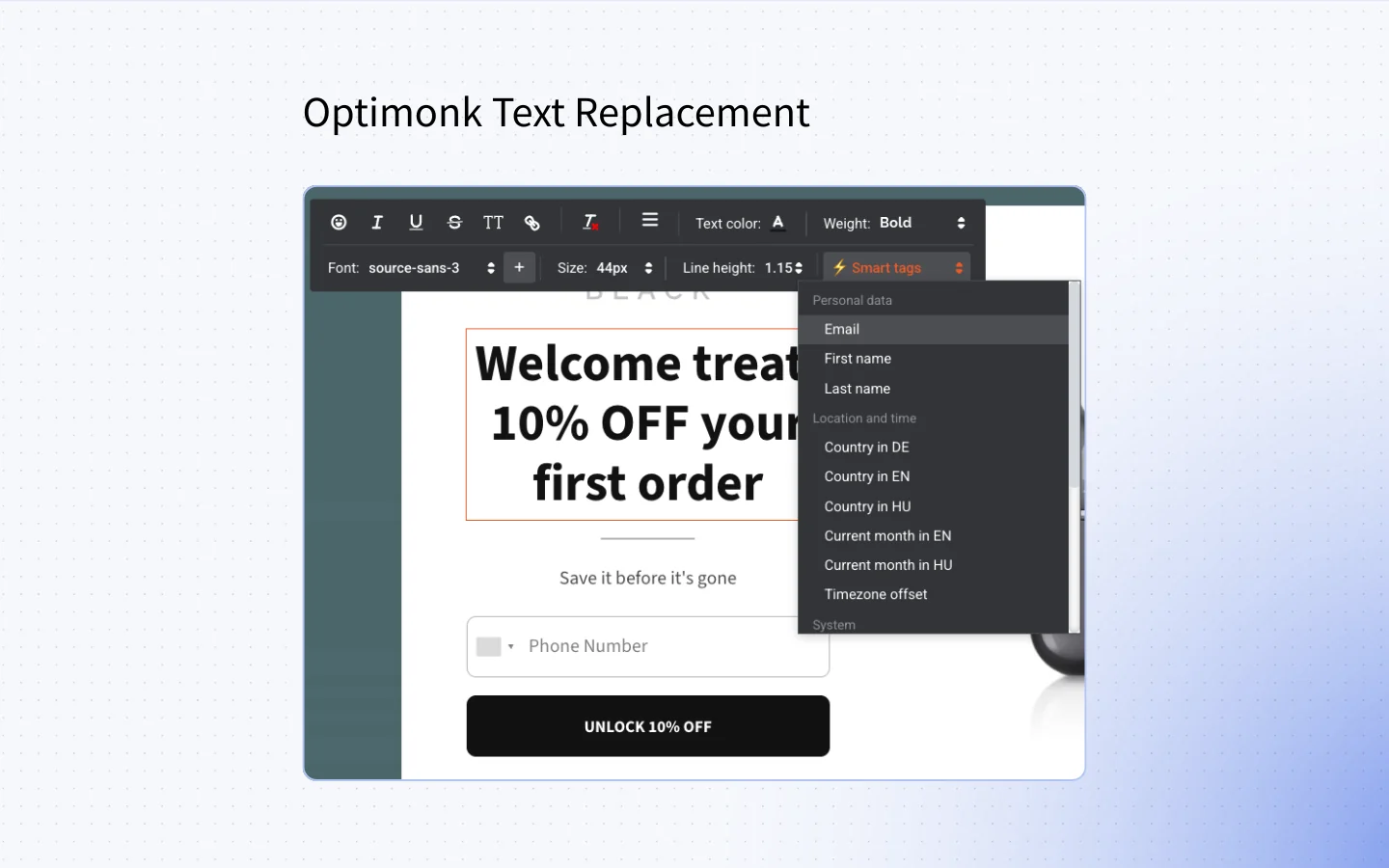
There’s no direct CRM connection for dynamic segments. If you want to change what users see based on past behavior, you’ll need to set up external syncing and maintain that data in other tools.
What to keep in mind: Personalization works well for surface-level changes, but not for complex or CRM-driven experiences.
Quick verdict
Pick Triggerbee when personalization is central to your strategy. Pick OptiMonk when name tags or location-based tweaks are enough.
5. Integrations
Your popup tool should fit into your existing tech stack — not work around it. The best platforms connect seamlessly to your CRM, email platform, and customer data sources.
Look for native integrations that support two-way syncing, audience targeting from your contact lists, and automated data handoffs. If you rely on real-time personalization or triggered emails, integration depth (not just quantity) becomes a key factor.
Triggerbee: Real-time, two-way integrations with CRM and email tools
Triggerbee offers deep native integrations with platforms like Rule, Klaviyo, Voyado, Mailchimp, MailerLite, and more. These aren’t just one-way lead captures – they’re full two-way syncs. You can both send and pull data from your CRM or email platform in real time.
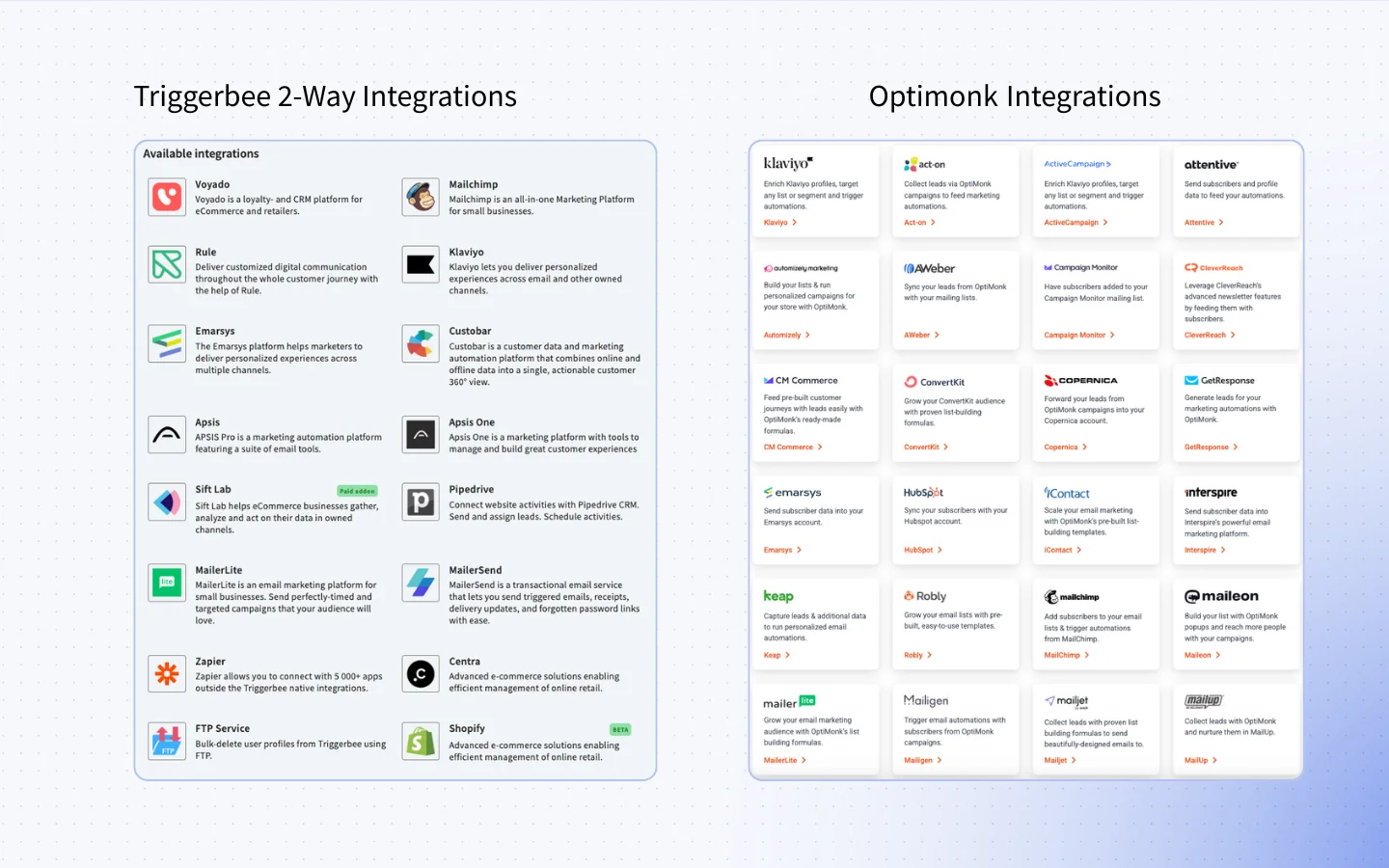
That means your onsite campaigns can dynamically respond to things like tags, segments, goals, purchases, or even subscription status. If you’re already using these tools, Triggerbee becomes an extension of your tech stack.
Why it matters: Less time spent managing lists or exports. More time building experiences that fit each customer.
Optimonk: Large integration library with stronger Shopify features
Optimonk integrates with a long list of ecommerce and marketing tools, including Klaviyo, Mailchimp, HubSpot, ActiveCampaign, and many more. These integrations mostly focus on pushing leads into your connected platform – with fewer options for pulling data back in.
That said, Optimonk does have a dedicated Shopify app that unlocks extra controls and easier setup for store owners. If you run your business through Shopify, this tight integration is a definite advantage.
What to keep in mind: OptiMonk wins on quantity. Triggerbee wins on data depth and syncing flexibility.
Quick verdict
Use Triggerbee when your strategy depends on CRM and email data that flows both ways. Use OptiMonk when your priority is getting started quickly with Shopify or a broad set of lead sync options.
6. Analytics & Optimization
When evaluating popup and personalization tools, analytics is more than just a “nice to have.” It’s what tells you if your campaigns are working, who they’re working for, and where you’re losing people.
At a minimum, you’ll want to track:
- Views and conversion rates – to measure basic performance.
- Split test results – to optimize headlines, offers, and formats.
- Funnel metrics / Drop-off points – especially in multi-step forms or quizzes.
- Revenue attribution – so you know which campaigns actually drive sales.
- Visitor-level insights – to understand how different segments behave.
The right tool gives you not just totals, but patterns. It should help you answer questions like: Which pages convert best? Are logged-in members more responsive? Which UTM campaigns produce the highest ROI?
Triggerbee: Built-in funnel analysis and revenue attribution
Triggerbee’s analytics go well beyond views and clicks. You can see assisted revenue, average order value, and campaign-specific funnel performance – all linked back to individual visitors and their behaviors. You also get clear reports on signups, engagement, and conversions.
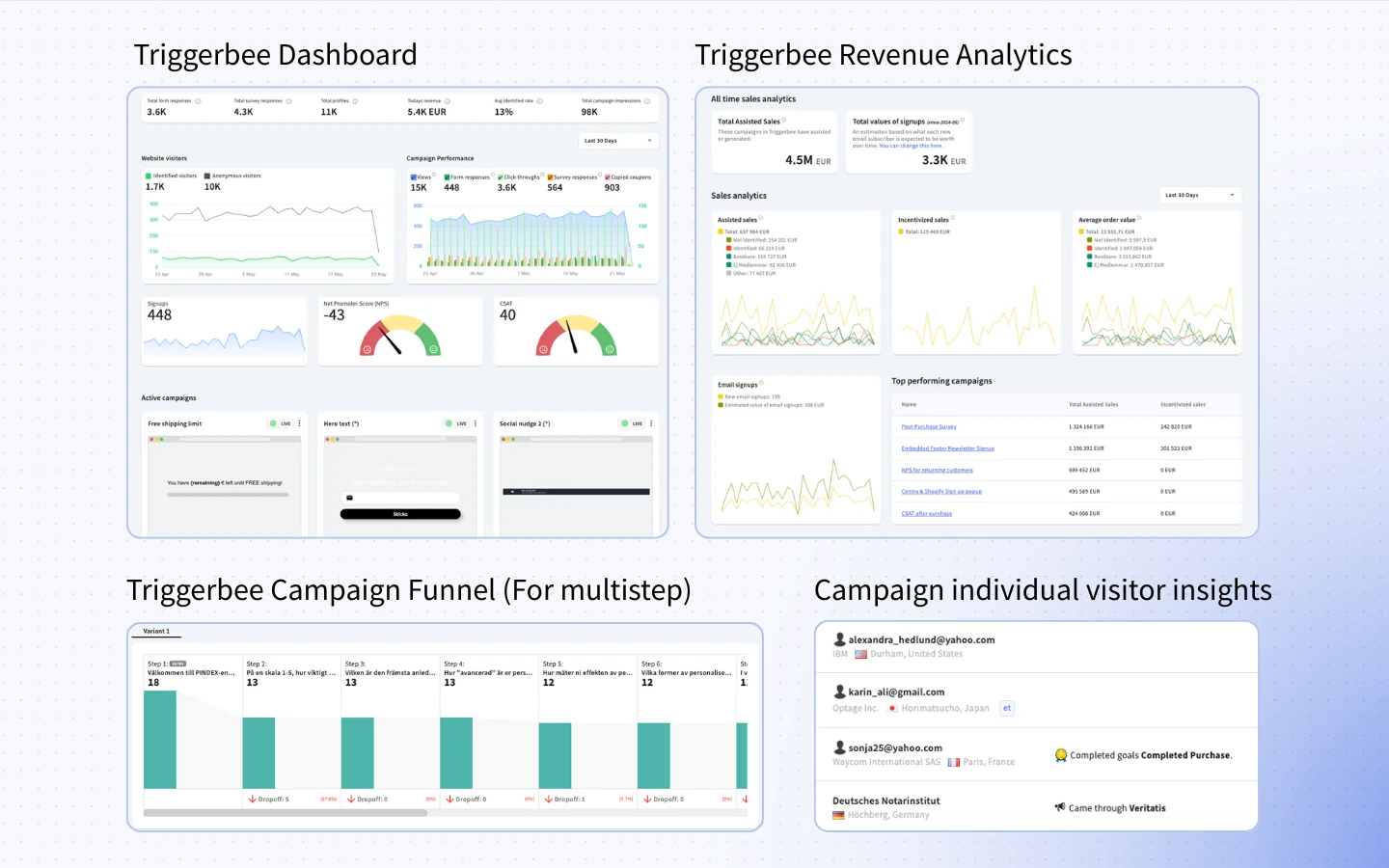
This means you can track the full journey from visitor to conversion, including what campaigns moved the needle. It’s especially valuable for teams using CRM tools and needing to connect onsite behavior to long-term performance.
Why it matters: You get the full picture – not just which popups were clicked, but which ones contributed to actual revenue.
Optimonk: Clean conversion dashboard with built-in performance stats
Optimonk includes an in-platform analytics dashboard where you can view impressions, conversions, conversion rate, assisted revenue, and impression value. You can filter by campaign or timeframe to see what’s working best.
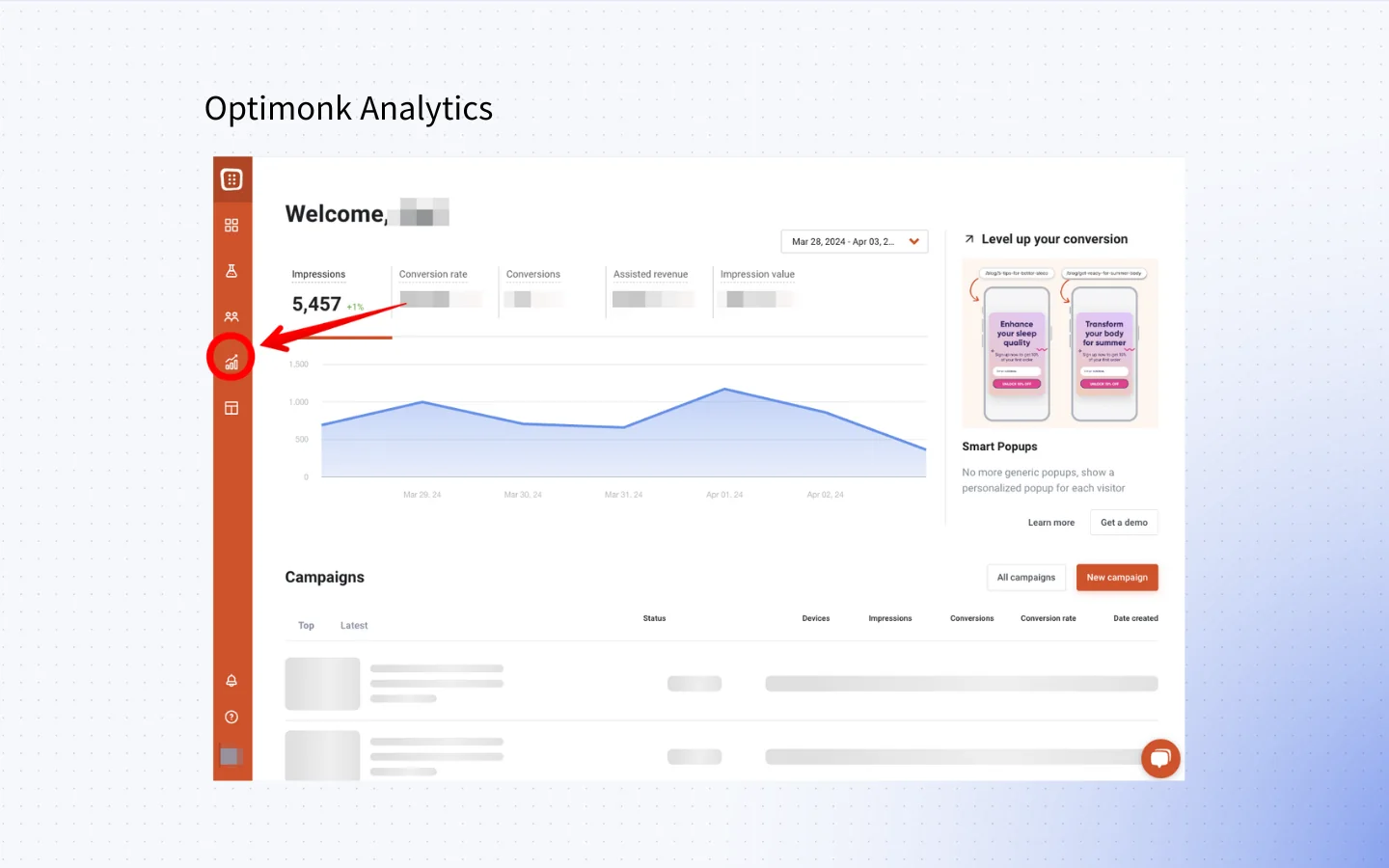
While it gives a strong overview of engagement performance, it doesn’t offer visitor-level journey mapping or CRM-linked revenue breakdowns. Still, for most teams looking for popup insights, it covers the core metrics well.
What to keep in mind: Easy to understand, great for campaign-level feedback – but not as detailed when connecting data across tools.
Quick verdict
Use Triggerbee if you want deep funnel views, revenue attribution, and CRM-level reporting. Use Optimonk when clean, easy-to-use engagement stats are enough.
7. Pricing & Plans
Here’s how pricing compares between Triggerbee and Optimonk across key traffic tiers:
| Monthly Page Views | Triggerbee Pricing (€) | OptiMonk Pricing (USD) |
|---|---|---|
| 50k | Essential: €39 | Pro: €63 | $44 |
| 100k | Essential: €63 | Pro: €96 | $69 |
| 250k | Essential: €108 | Pro: €132 | $129 |
| 500k | Essential: €137 | Pro: €216 | $179 |
| 1M | Essential: €195 | Pro: €303 | $299 |
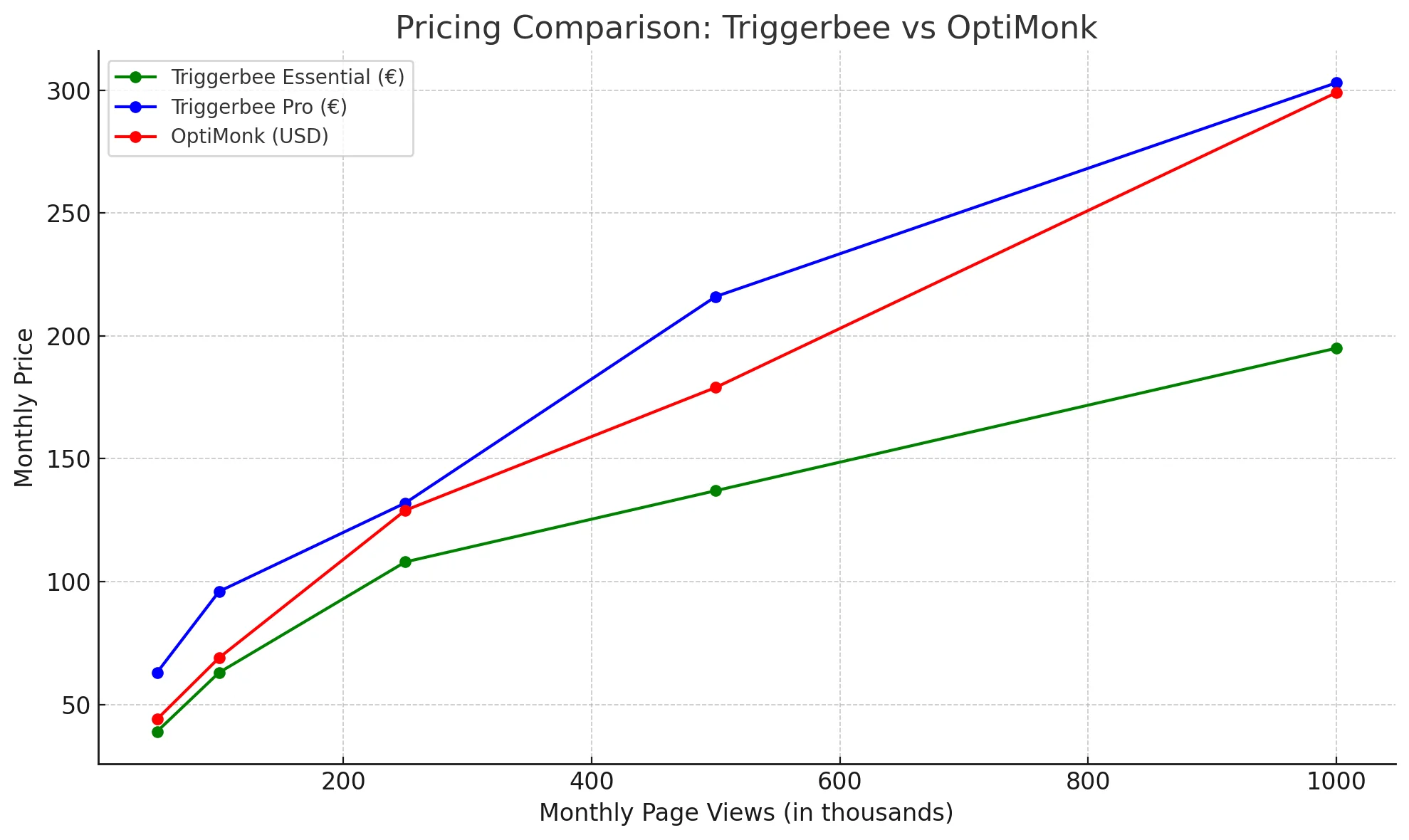
Triggerbee pricing
Triggerbee’s pricing starts at €39, but most customers choose the Pro plan to unlock all personalization features. Unlike many tools, all Pro users get access to referral marketing, advanced targeting, smart embeds (dynamic placeholders), and full CRM integrations. And as your traffic grows, the price curve stays predictable – you don’t get hit with sudden jumps.
Optimonk pricing
Optimonk starts strong with a free tier (10k pageviews), and offers an affordable Essential plan for smaller brands. But once your traffic crosses 250k, the monthly price rises quickly. Advanced optimization and some Shopify-specific tools are only available on higher plans.
Pricing verdict: Feature depth stays consistent at every level
While Optimonk offers a lower entry price, Triggerbee’s pricing stays predictable even as traffic scales. Triggerbee’s Essential plan has all the basic features you need if you’re just looking for smart forms with great features and some gamification capabilities. It includes CRM sync and full personalization which are features that often require a higher-tier plan elsewhere.
For teams looking for reliable access to advanced targeting and one-to-one marketing at any scale, Triggerbee delivers consistent value without needing add-ons or upgrades.
8. Pros & Cons
Triggerbee Pros
- CRM-driven personalization and segmentation
- Built-in revenue and campaign funnel analytics
- Smart Embeds for onsite content personalization
- Two-way syncing with Klaviyo, Rule, Mailchimp, Voyado etc.
- Full control over brand styles and logic
Triggerbee Cons
- No free tier
- Slightly higher price at lower traffic levels
- More advanced setup if you’re not already using CRM data
Optimonk Pros
- Free plan up to 10,000 pageviews
- Large template library and simple campaign builder
- Dedicated Shopify integration
- Light learning curve for small teams
- Helpful Smart Tags and behavioral targeting
Optimonk Cons
- Most CRM integrations are one-way lead sync
- Limited layout/design flexibility
- Full personalization and analytics require higher plans
9. Final Verdict
Choose Optimonk if you want something that’s easy to launch, affordable at lower traffic levels, and plays well with Shopify out of the box. It’s a great solution for ecommerce stores that need to move fast and want good performance without a lot of setup.
Choose Triggerbee if you need advanced targeting, real-time CRM syncing, or the ability to personalize the entire customer experience based on who someone is and what they do. It gives you more control, deeper integrations, and full funnel analytics.
Triggerbee offers slightly more advanced segmentation, personalization, and reporting.
In terms of the editing experience and capabilities, both tools are nearly identical with the exception for Triggerbee offering specific survey features and analytics.
